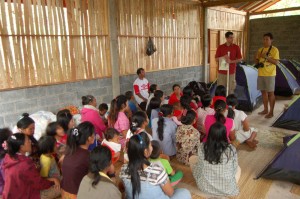A group of interdisciplinary Drexel students recently visited Thailand for a two-week trip, where they worked with farmers in the Bo Klua region to improve rice planting techniques from June 14 to June 28.
Three students and one adviser were part of the Thai Harvest Initiative, a group of six students from Drexel’s College of Engineering; School of Biomedical Engineering, Science and Health Systems; and the Westphal College of Media Arts & Design. The students devoted their senior projects to helping farmers in Thailand, specifically the small village of Ban Nam Khe.
The student members of the Thai Harvest Initiative are mechanical engineering students Marie LaPosta, Kathleen Rizzo and RJ Bauer; biomedical engineering student Phuong Diep-Lam; and graphic designer Kathryn VenVertloh. They were advised by James Tangorra, an assistant professor of mechanical engineering, and National Science Foundation Research Fellow Alex Moseson, who also received his bachelor’s degree in mechanical engineering and a master’s degree in materials science and engineering from Drexel.

LaPosta, Bauer, VenVertloh and Moseson made the trip to Thailand, with Drexel paying the airfare, Tangorra said.
“Also, in addition to paying airfare, Dr. [Julie] Mostov from the international studies office contributed a nice portion of money to help buff the cost. And the mechanical engineering department gave $500, and Westphal contributed $600 to the project, so a lot of people contributed money, but the students also did. In this case, they raised several thousand dollars from family and friends and themselves,” Tangorra said.
Moseson had previously made two visits to the area in August of 2009 and November of 2010 to assess the medical and agricultural needs of the village.
The Thai Harvest Initiative website states, “We believe that technology can’t just work technically — it must also work for people socially, economically and environmentally. Current designs nearly eliminate pain, cut sowing time by 50 percent, and have the potential to increase rice yields. The design takes advantage of local materials and capabilities and minimizes costs to the villagers.”
The students brought to Thailand a prototype of the device they created to ease the burden of planting rice, as well as handouts showing how to create a prototype.
“You can’t send over a lot of written instructions, because it’s not the same language, so we always take a standpoint of building an Ikea manual that just has pictures, and as long as they’re general enough — you don’t want to say, ‘Go get this piece of material,’ it has to be, ‘Go find something that’s flat and put holes in it.’ It could be metal or wood,” Tangorra said.
The tool created is a long tubular instrument, made from PVC pipe and steel sheeting that stores seeds, digs a hole and drops in the correct number of rice all in one step. It punches a hole in the ground with a spike and puts the right amount of rice into the dirt.
This consolidates the labor of what would normally be a two-person task, with one person creating random holes in the steep, rocky slopes of the region and another person, usually a woman, following behind, crouching over to place a handful of rice in the holes while avoiding any rocks or dirt that the person in front of them accidentally kicks back.
The device holds the rice inside, instead of in a backpack, and can usually hold enough rice to last for up to an hour’s worth of work. In addition to cutting labor, the tool lessens the chronic strain on the farmers’ backs due to rudimentary tools, a difficult terrain and constantly bending over to dig and plant the seeds.
The estimated cost of the tool is between $5 and $10, which includes buying raw materials and paying someone for labor. Because the planting season for rice is so small, sometimes as little as two weeks, farmers often hire 20 to 40 people at a time for $5 a day.
“If I used to hire 40 people for $5 a day, now I can hire 20 people and buy 20 devices for them to use. So if I use it more than one time, then it’s paid for itself,” Moseson said.
“One of the core differences about these types of projects is that they’re not designing for a normal customer. They’re trying to figure out, what do people really need? What can they build on their own? So the requirements from a stakeholder’s perspective are a little different. You have to spend a lot more time understanding cultural differences and manufacturing differences. You can build wonderful things here in our machine shops, but you can’t execute that in the field, where you have to figure out how to do it with bamboo and hand tools,” Tangorra said.
The team worked with villagers, three interpreters and two volunteers from a non-government organization called the Sustainable Development Research Foundation to improve and build the tools. By the end of the trip, the students trained the farmers and the volunteers in making and using the tool.
The group also produced four prototypes of the device created with materials found in the village, one of which was brought back to the U.S. with the students. Additionally, the students left behind 10 manuals and plan on sending electronic copies of the manual detailing the improved device with corrections of problems found while working with the farmers during the trip.
“Let’s take the analogy a step further. We’re not even teaching a man how to fish. We’re walking alongside a man to come up with fishing rod,” Moseson said. “Our end goal is for [the villagers] to not need us anymore. We would love to see them go beyond what we’ve already done.”
The farmers and SRDF volunteers expect to spread the technology throughout the Bo Klua region of 30,000 people, as well as throughout the country and into Laos, with the cooperation of the government.

